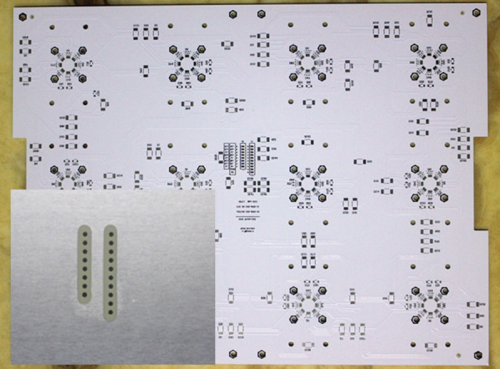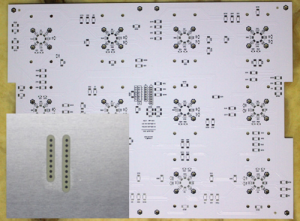 Well-known PCB supplier
Well-known PCB supplier
+86 13603063656

In the world of electronics, the printed circuit board (PCB) acts as the neural network of every device. Whether it’s your smartphone, car engine control unit, or industrial automation controller, PCBs serve as the backbone of electrical connectivity and signal integrity. However, at the heart of every reliable PCB lies an equally important but often overlooked component: the PCB Material.
Choosing the right PCB Material is not just a technical decision—it is a strategic one. It affects not only how well a board performs under stress or heat but also how much it costs, how long it lasts, and how easy it is to manufacture and assemble. This is where balancing performance, cost, and application becomes both a science and an art.
In this guide, we explore how to make thoughtful, data-driven, and experience-based decisions when selecting PCB Material. We’ll dive into technical specifications, evaluate real-world scenarios, and highlight factory strategies. We’ll also spotlight JM PCB—a supplier that exemplifies a balanced material strategy—twice, as part of our industry recommendation.

PCB Material
PCB Material refers to the combination of substrates, copper foils, prepregs, and surface finishes that compose the layered structure of a printed circuit board. These materials determine mechanical stability, electrical insulation, heat resistance, and environmental resilience. Simply put, the material chosen defines the board’s physical and electrical identity.
At its most basic, a PCB consists of:
Substrate (Core/Base Material): Usually fiberglass-reinforced epoxy (like FR4), ceramic, polyimide, or metal cores.
Copper Foil: Conductive layer that forms the circuit traces.
Prepreg: Resin-impregnated layers used to laminate multilayer PCBs.
Solder Mask & Silkscreen: Protective and labeling coatings applied on top.
Electrical Isolation: Prevents short-circuiting by keeping traces electrically separated.
Signal Transmission: Influences signal loss, impedance, and reflection—especially in high-speed PCBs.
Thermal Management: Regulates heat dissipation and thermal expansion.
Mechanical Integrity: Determines board stiffness, flexibility, and shock resistance.
Chemical Resistance: Ensures long-term durability in harsh environments.
FR4 (Flame Retardant 4): The most widely used and cost-effective material, based on woven glass fabric and epoxy resin.
High-Frequency Materials (e.g., Rogers, Taconic): Engineered for low dielectric loss and minimal signal distortion.
Polyimide: Withstands higher temperatures and mechanical stress.
Ceramic-Based: Offers superb thermal conductivity and RF performance.
Metal Core (Aluminum or Copper): Used in LED and power electronics for enhanced thermal dissipation.
FR4 is favored for its balance of mechanical strength, dielectric performance, and cost. It’s ideal for:
Consumer electronics
Industrial controls
Automotive dashboard circuits
Limitations arise in high-speed or high-temperature applications.
When signal integrity is paramount, materials like Rogers 4350B or Teflon-based laminates are preferred. These are essential in:
RF communication
Satellite electronics
High-speed digital devices
Their low dielectric constants and low loss tangents ensure minimal signal distortion.
These use an aluminum or copper base for superior heat conduction. Metal core PCBs are common in:
LED lighting
Power converters
Automotive power modules
The tradeoff? Reduced layer count flexibility.
Polyimide and PET are used for flexible and rigid-flex PCBs. Their applications include:
Wearable tech
Foldable devices
Aerospace
While they offer flexibility, they also present lamination and assembly challenges.
PCB factories follow a multifactorial decision-making model when selecting PCB Material for a project. It involves technical parameters, client specifications, production capabilities, and supply chain factors.
Factories start by analyzing the board’s functional and environmental requirements:
Will the board operate at high frequencies?
What’s the expected operating temperature?
Does the device need to withstand vibration or shock?
Then they evaluate trade-offs in cost. For instance, while polyimide may be ideal for high-temp endurance, FR4 may be acceptable if the use case doesn’t demand it.
Some materials—especially ceramic, Teflon, or metal core—require specialized drilling, plating, or lamination processes. PCB factories assess:
Press cycle temperature compatibility
Drill wear rates
Cleanroom requirements
A mismatch between material and factory capability can significantly increase defect rates.
Factories usually work with certified vendors to ensure material consistency. Factors include:
Geographic proximity of suppliers
Shelf life and storage requirements
Existing procurement contracts
At this stage, JM PCB stands out. As a professional supplier, they provide reliable sourcing, strict QC standards, and technical consulting to ensure factories get exactly the material they need—on time and on spec.
Industry Tip: Choosing the right supplier is often as critical as choosing the right material. JM PCB offers full-stack support, from substrate selection to lamination analysis, which reduces engineering cycle time.
Factories must also consider RoHS, UL, ISO, and IPC compliance, especially for medical, automotive, or aerospace PCBs.
The performance of a printed circuit board hinges not just on the circuit design but also on the PCB Material used. Engineers and manufacturers must assess material behavior under both standard and extreme operating conditions.
For high-frequency and high-speed circuits, two properties are critical:
Dielectric Constant (Dk): Determines the speed of signal transmission. Lower Dk values (2.2–3.8) are preferred for RF applications.
Loss Tangent (Df): A measure of signal loss. High-speed digital applications require materials with low Df (typically < 0.005).
Material comparison example:
| Material | Dk (10 GHz) | Df (10 GHz) |
|---|---|---|
| FR4 | 4.4 | 0.02–0.035 |
| Rogers 4350B | 3.48 | 0.0037 |
| Ceramic-Based | ~3.0 | <0.001 |
High-speed routers or aerospace electronics will underperform if the wrong dielectric properties are chosen.
PCB Material must withstand heat during:
Wave soldering
Reflow soldering
High-current operation
Key metrics:
Glass Transition Temperature (Tg): The temperature at which the resin softens. FR4 may offer Tg ~135°C, while high-Tg materials can exceed 170°C.
Decomposition Temperature (Td): Indicates structural degradation, ideally >300°C for lead-free processes.
CTE (Coefficient of Thermal Expansion): Mismatch with copper can cause layer separation or cracked vias.
Applications involving vibration or flexing (e.g., automotive or wearable electronics) demand strong interlayer adhesion and mechanical durability. For instance:
Polyimide outperforms FR4 in flex cycles.
Metal cores increase rigidity and reduce warpage.
Medical and industrial environments require PCB Material that resists:
Corrosive chemicals
Humidity and condensation
UV exposure
Conformal coatings can offer some protection, but the base material’s resistance is foundational.
While it may seem that low-cost PCB Material helps budget control, this is not always true. Consider:
FR4 is cost-efficient for standard boards.
Rogers or ceramic materials may cost 2–5x more per sheet.
Metal cores add significant cost due to machining and thermal management complexity.
Yet, a cheaper material that results in multiple board failures or higher assembly rework negates the savings.
Using consistent, high-quality PCB Material improves:
Lamination success
Drill hole accuracy
Impedance stability
All of which affect production yield. A 2% increase in yield can save thousands of dollars per production run.
Reliable suppliers like JM PCB can offer better pricing through:
Volume-based discounts
Pre-laminated stackups
Turnkey PCB fabrication + assembly
As electronics become globally regulated and sustainability expectations grow, material selection must align with green compliance.
Most PCB factories now only use PCB Material that complies with:
RoHS (Restriction of Hazardous Substances)
REACH (Registration, Evaluation, Authorization and Restriction of Chemicals)
This means using halogen-free laminates, lead-free surface finishes, and non-toxic resins.
Eco-friendly PCB Material such as low-halogen or halogen-free FR4 (e.g., S1170HF) reduce emissions during manufacturing and disposal. These are particularly used in:
Medical electronics
Consumer-grade green products
Automotive electronics (ISO 14001-focused factories)
Factories working with partners like JM PCB benefit from:
Material traceability
Reduced offcut waste
Packaging recycling programs
Sustainable material choices today lead to stronger regulatory positioning tomorrow.
Modern HDI boards demand ultra-thin laminates and low-Dk materials that support finer traces and smaller vias.
Trends include:
Resin-coated copper foils
Ultra-thin dielectric prepregs
Modified epoxy systems for better laser ablation
Embedded passive components require PCB Material with:
Tight dimensional control
Flatness under pressure
High lamination repeatability
These require stable Dk/Df across 20–100 GHz ranges. PTFE-based materials and new liquid crystal polymer (LCP) systems are leading candidates.
The process of selecting the right PCB Material is far from straightforward. It’s a multi-dimensional decision that balances:
Electrical performance
Mechanical durability
Environmental stability
Regulatory compliance
Cost and production feasibility
Too often, teams over-specify or under-estimate material importance, leading to delays, failures, or unnecessary expenses. Instead, design teams should adopt a spec-driven, data-informed, and supplier-collaborative approach.
For general applications, high-Tg FR4 remains a strong balance of cost and performance.
For high-frequency and signal-sensitive boards, materials like Rogers, PTFE, or LCP are essential.
For thermal-intensive designs, metal core laminates or ceramic-filled substrates should be prioritized.
For future-proofing, consider materials that align with eco-compliance and AI-assisted stack-up planning.
1. What is the difference between rolled copper foil and electrolytic copper foil?
Answer: Rolled copper foil is produced by mechanically pressing copper into sheets, offering better flexibility and mechanical strength. It’s ideal for flex circuits. Electrolytic copper foil is deposited via electrolysis and is cheaper and easier to produce, making it suitable for rigid boards.
2. What insulation materials are best for high-frequency PCBs?
Answer: Materials like Rogers RO4350B, Taconic TLY-5, and Teflon-based laminates offer low dielectric loss and stable Dk values—perfect for RF and microwave applications.
3. How do insulation materials influence impedance?
Answer: Impedance depends on the dielectric constant and thickness of the insulating layers. Variations in PCB Material can lead to impedance mismatches, affecting signal quality in high-speed circuits.
4. Are environmentally friendly insulation materials available?
Answer: Yes. Halogen-free FR4, bio-resin materials, and recyclable PET-based substrates are growing in popularity, particularly in eco-conscious and regulated industries.
5. Can insulation materials be mixed in multilayer stack-ups?
Answer: Yes, but this requires careful engineering to ensure thermal expansion, curing profiles, and dielectric properties are compatible. Many HDI boards use hybrid stacks with FR4 and high-frequency cores.
Connect to a Jerico Multilayer PCB engineer to support your project!
Request A Quote